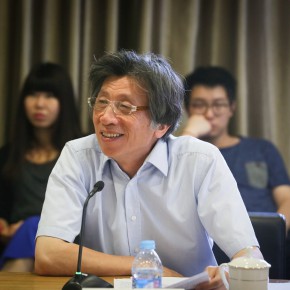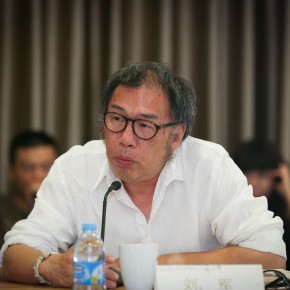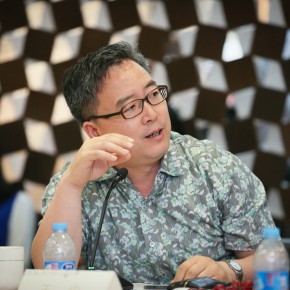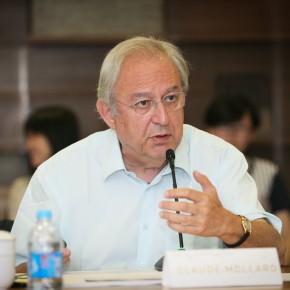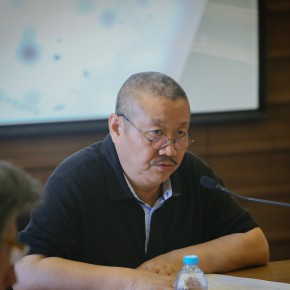
On the morning of June 7, 2014, hosted by the CAFA, organized by School of Design, School of Humanities, CAFA, and CAFA Art Museum, the academic conference on “Field ? Space, Display and Museum” was held at the VIP meeting room in CAFA Art Museum. First of all, host Professor Yu Ding introduced the background of the activity and presented the guests. In recent years, with the rapid rise in the Chinese economy, Chinese art exhibitions are the most active and fastest growing across the world, while the development of the private art museums in China are also in focus across the world, more and more art activities and fairs take the space of museums as the spaces of choice for art, so that these spaces become a cultural field. The discussion was unfolded within the background of “field” and “Huang Jiancheng Design”.
The conference invited 6 guest speakers, including Fan Di’an, Director of the National Art Museum of China, Claude Mollard, French politician and writer, Liu Jun, Deputy Dean of School of Humanities, CAFA, famous poet, Matthias Hankel, Vice Chairman of German Museums Association, Huang Jiancheng, Deputy Dean of the School of Urban Design, Klaus Max Siebenhaar, Dean of the School of Culture and Media Management of the Free University Berlin in Germany. In addition, the teachers and students from the Schools of Urban Design, Humanities, Architecture and Design attended the conference, including Professor Lv Pinjing, Dean of the School of Architecture, Professor Xu Zhongou, Dean of the School of Urban Design, Professor Wang Zhong, Deputy Dean of the School of Urban Design, Professor Cheng Qiming, Associate Professor Cao Qinghui, Deputy Director of the Department of Art History of the School of Humanities, etc.
Before the start of the keynote speech, Xu Zhongou, Dean of the School of Urban Design gavean opening address, after introducing the teams of the School of Urban Design, he briefly evaluated the work of Huang Jiancheng.
First of all, Fan Di’an delivered a keynote speech entitled “The Scene and Experience: New Valuesin the Museum”. At the beginning of the speech, Fan highly praised the exhibition of Huang Jiancheng, and his team proposed a research topic and explored the solution, which focused on the mutual relationships between the cultural quality of design, the contemporary, functional and artistic quality, which accurately grasped the issues that are faced with Chinese design in the era of globalization. Fan Di’an thought it was necessary to salute three key issues in the design of the art museum and the spatial design. First of all, from viewing to experiencing, it made the space of the museum and exhibited items come together to create an appreciated visual world. Secondly, from time to space, it transformed time to space, reading work in the field, instead of in a single direction. Thirdly, the transformation of traditional resources, it didn’t simply change the old tradition to the new one, but the new one should include natural experiences within the current background of knowledge, of a worldwide significant cognitive achievement.
Matthias Hankel’s speech was entitled “Space, Time, and Honor – The Difference and Integration of the Museum as a Capital Symbol”. From a philosophical level, Hankel combed through the discussion on space in Western history, eventually returning to the contemporary, while entering the space of the museum, entering the internationalism of narrative. Matthias Hankel said the museum was the best place for experiencing, an experimental space for interaction, laboratory, stage, showroom, useful for all functions, and was a space shared by the whole world.
Professor Liu Jun gave a speech entitled “The Masses, Elite and Pioneer Culture”. Liu Jun thought the topic had a relationship with urban life and the cultural taste of the city, so he initially introduced China’s current urbanization rate, the current China’s urbanization rate was about 51%, if one removed the migrant workers, it was about 30%. The culture of the Chinese pioneer was a part departed from elite culture, and most of them were liberal, but the majority of Chinese pioneering artists eventually returned to the circle of the elite. Then he talked about two types of Chinese artists, the first kind was supported by the international capital, the second one was supported by China’s national capital. If an artist was driven by the international capital, he or she had to use the surplus cultural value of socialism. Any Chinese artist not being promoted by international capital would show the depoliticizing life and the interesting themes and their ultimate goal was to become a successful artist, while the successful artist would be a part of fashionable life, but actually many foreign artists weren’t a part of the fashion life. Of course, Chinese artists still played a positive role in transforming China’s life.
Claude Mollard gave a lecture entitled “Art Practice of the Museum and the Decentralization”, taking the Pompidou Center as an example to discuss the concept of a cultural start in detail, namely cultural projects; the expansion of cultural practices; dissemination to the public, as well as artistic and cultural education, etc.
Prof. Huang Jiancheng’s speech was themed “Show, Display and Multivariate Spaces”. In his speech, Huang through telling the design process and implementation of specific design cases, including three typical cases: scheme of Expo 2015 Milano, Hunan Provincial Museum, as well as the ongoing design of the Zoomlion Construction Machinery Pavilion, to explain his understanding of art in the field and the practice.
The last speaker was Klaus Max Siebenhaar who brought a lecture entitled “Culture = Capital: Bourdieu, Cultural Capital and the Space of Museum”. Klaus combined the real case of the museum to analyze the field theory of Pierre Bourdieu. At the same time, Klaus gave a detailed analysis of the capital exchange, in addition, talked about different types of museums in the field and the developmental trends.
After the end of the first section of the keynote address there was a short free discussion time, the present guests continued to further discuss and exchange on the related issues of “field”. The host, Yu Ding finally concluded that the conference would unfold around the issue of field, the display space which was as the production of knowledge, being full of a variety of competitive powers. It was the mutual relationship of these competitive strengths that were interwoven and created the “field”, to influence contemporary society, the contemporary culture and contemporary life.
Text: Ye Yuanfeng, translated by Chen Peihua and edited by Sue/CAFA ART INFO
Photo: Hu Zhiheng, Quan Jing/CAFA ART INFO



